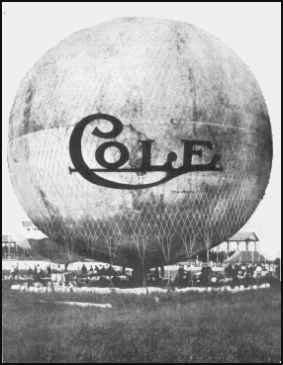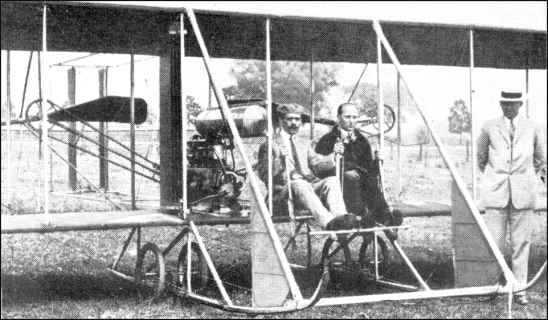

1869-1925 |
 |
 |
May 30, 1911 |
Cole Motor Car Company |
|
Courtesy of Leroy D. Cole |
|
These photos have been copied from an original Cole Bulletin (Vol 4 #2) published in late 1917. It introduces the 1918 Cole Aero Eight and connects its development with the Cole Aeroplane. From the same bulletin we include an article entitled, "The Aero Eight--A Dream Come True," Cole's own account of his airplanes back-ground. One must remember how young the airplane was when Cole undertook the Continental Race. Cole was the first Auto Manufacturer to get into flying, first to put his car engine in an airplane, first Auto Manufacturer to fly cross country. His interest in flying was a part of his interest in transportation. Cole met many challenges but was never addicted to them. He tasted the success of flying but never attempted to produce planes. His first love was the automobile and he spent his life focused on it. Courtesy of Leroy D. Cole |
 |
|
|
|
Extract from "History of the Cole Motor Car Company" by Howard Delancy Dr. L.E. Custer, of Dayton, Ohio, made a spectaculat flight in the Cole balloon at Kansas City. He was finally forced down by high winds and lightning, but not until he had managed to keep the craft in the air for nine hours and forty minutes. The big balloon's flights always warranted an article or two from the wires of the Associated Press." |
SOUTHWEST COURSE Aeronauts Carried in Wide Circle Last Report From Gosport. The Cole ballon, piloted by Capt. G. L. Burnbaugh, with Andrew Farrell, of The Star as aid, was carried southwest when it arose at the plant of the Indianapolis Gas Company shortly before 4' o'clock yestereday afternnon, but later took a southeasterly direction and at 9:45 o'clock last evening had turned again to the west and had passed over Gosport. The balloon there was flying about twice as high as the trees, and the aeronauts, speaking through a megaphone, asserted that they were having no trouble, but were traveling in a circle and that the wind was poor. Shortly before reaching Hope, from where the balloon was reported at 7:30 o'clock, the balloon sailed over Providence, Ind., and at that point Capt. Burnbaugh and his aid reported that variable air currents were causing some trouble. There the balloon was low, not much above the tree tops. Earlier in the evening the Cole passed three miles south of Smith's Valley. The message follows: "Made perfect ascension. Air warmer than on earth; passing over city at an elevation of 2,000 feet; are moving southwest; wind about twenty miles an hour, but we hope to find faster one about 4,000 feet. Excellently equipped and everything looks good for recordbreaker." The flight was made as Capt. Burnbaugh's effort of the year to "lift" the Lahm Cup, which is offered for distance records only. The day was almost ideal and the start was witnessed by a crowd. The gas was of good quality and, barring the possibility of extremely cold weather, which would decrease its lifting power greatly, the outlook for a long flight was good. The balloon was fitted by the Cole Motor Car Company, owners of the bag, with everything necessary for the safety and comfort of the aeronauts. |
 |
 |
|
|
|
Experiments Begun by J. J. Cole in 1911 Culminate with Creation of New Car Embodying Improved Features of Aerotype Design. THOUGH the Cole Aero-Eight, which made its initial appearance at the New York Automobile Show last January, has been heralded as the sponsor of an entirely new vogue in automobile designing and has come to be regarded as one of the foremost developments in motor car engineering thus far conceived by American builders, the way for it was paved almost seven years ago by J. J. Cole, president of the Cole Motor Car Company, its builders. In 1911 the Cole Company began its experiments with aviation motors as a basis for subsequent research to discover whether aeroplane construction offered any features which might be incorporated to advantage in automobile designing. At that time a prize of $50,000 was offered to any aviator who would successfully cross the continent in an airship--as they were called in that day. The start was made at San Francisco on September 11, 1911. It was Fowler's aim to reach New York in thirty days and win the trophy. Though he went farther than any other aviator had gone up to that time, he was balked when he reached the Rockies. Cross winds and high altitudes had not been mastered by the aeroplane builders then. Realizing that he cold not finish the journey within the required time, Fowler gave up hope of winning the trophy and returned to San Francisco. He started out anew, however, this time directing his plane toward Jacksonville, Fla. He succeeded in crossing the continent by this route and though the Cole Company was not successful in annexing the $50,000 prize--which, by the way, was withdrawn finally--the experience that was gained from Fowler's experiments was invaluable. Further experiments were carried on. He reverted to his study of the aeroplane, realizing at the outbreak of the war that greater development would result in this field of machinery than in any other related to motor car building. It is doubtful whether any manufacturer by a single stroke of genius has ever before so completely altered and improved not only the artistic but the mechanical standards of his trade as has J. J. Cole with his Aero-eight. How thoroughly the public has approved his production may be judged best by the popularity of the Aero-Eight. It is without question the most sensational success ever offered by Cole. |
 |
|
Model 871 |
 |
|
Model 870 |
 |
|
Model 872 |
 |
|
|
 |
|
This must be close to 1925: note the aging automaker. |
 |
For the story of one of the first dealers of the Cole Aero Eight, click on: E. L. Cunningham |
|
|


|